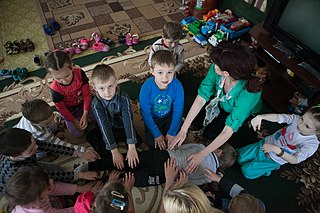Related Research Articles

A time-out is a form of behavioral modification that involves temporarily separating a person from an environment where an unacceptable behavior has occurred. The goal is to remove that person from an enriched, enjoyable environment, and therefore lead to extinction of the offending behavior. It is an educational and parenting technique recommended by most pediatricians and developmental psychologists as an effective form of discipline. During time-outs, a corner or a similar space is designated, where the person is to sit or stand. This form of discipline is especially popular in Western cultures.

Abnormal psychology is the branch of psychology that studies unusual patterns of behavior, emotion, and thought, which could possibly be understood as a mental disorder. Although many behaviors could be considered as abnormal, this branch of psychology typically deals with behavior in a clinical context. There is a long history of attempts to understand and control behavior deemed to be aberrant or deviant, and there is often cultural variation in the approach taken. The field of abnormal psychology identifies multiple causes for different conditions, employing diverse theories from the general field of psychology and elsewhere, and much still hinges on what exactly is meant by "abnormal". There has traditionally been a divide between psychological and biological explanations, reflecting a philosophical dualism in regard to the mind-body problem. There have also been different approaches in trying to classify mental disorders. Abnormal includes three different categories; they are subnormal, supernormal and paranormal.

Occupational therapy (OT) is a healthcare profession. It involves the use of assessment and intervention to develop, recover, or maintain the meaningful activities, or occupations, of individuals, groups, or communities. The field of OT consists of health care practitioners trained and educated to improve mental and physical performance. Occupational therapists specialize in teaching, educating, and supporting participation in any activity that occupies an individual's time. It is an independent health profession sometimes categorized as an allied health profession and consists of occupational therapists (OTs) and occupational therapy assistants (OTAs). While OTs and OTAs have different roles, they both work with people who want to improve their mental and or physical health, disabilities, injuries, or impairments.
Antisocial behaviours are actions which are considered to violate the rights of others by committing crime or nuisance, such as stealing and physical attack or noncriminal behaviours such as lying and manipulation. It is considered to be disruptive to others in society. This can be carried out in various ways, which includes, but is not limited to, intentional aggression, as well as covert and overt hostility. Anti-social behaviour also develops through social interaction within the family and community. It continuously affects a child's temperament, cognitive ability and their involvement with negative peers, dramatically affecting children's cooperative problem-solving skills. Many people also label behaviour which is deemed contrary to prevailing norms for social conduct as anti-social behaviour. However, researchers have stated that it is a difficult term to define, particularly in the United Kingdom where many acts fall into its category. The term is especially used in British English.
Attachment disorder is a broad term intended to describe disorders of mood, behavior, and social relationships arising from unavailability of normal socializing care and attention from primary care giving figures in early childhood. Such a failure would result from unusual early experiences of neglect, abuse, abrupt separation from caregivers between three months and three years of age, frequent change or excessive numbers of caregivers, or lack of caregiver responsiveness to child communicative efforts resulting in a lack of basic trust. A problematic history of social relationships occurring after about age three may be distressing to a child, but does not result in attachment disorder.
Reactive attachment disorder (RAD) is described in clinical literature as a severe and relatively uncommon disorder that can affect children, although these issues do occasionally persist into adulthood. RAD is characterized by markedly disturbed and developmentally inappropriate ways of relating socially in most contexts. It can take the form of a persistent failure to initiate or respond to most social interactions in a developmentally appropriate way—known as the "inhibited form". In the DSM-5, the "disinhibited form" is considered a separate diagnosis named "disinhibited attachment disorder".

Play therapy refers to a range of methods of capitalising on children's natural urge to explore and harnessing it to meet and respond to the developmental and later also their mental health needs. It is also used for forensic or psychological assessment purposes where the individual is too young or too traumatised to give a verbal account of adverse, abusive or potentially criminal circumstances in their life.
Flooding, sometimes referred to as in vivo exposure therapy, is a form of behavior therapy and desensitization—or exposure therapy—based on the principles of respondent conditioning. As a psychotherapeutic technique, it is used to treat phobia and anxiety disorders including post-traumatic stress disorder. It works by exposing the patient to their painful memories, with the goal of reintegrating their repressed emotions with their current awareness. Flooding was invented by psychologist Thomas Stampfl in 1967. It is still used in behavior therapy today.

Complex post-traumatic stress disorder (CPTSD) is a stress-related mental disorder generally occurring in response to complex traumas, i.e. commonly prolonged or repetitive exposures to a series of traumatic events, within which individuals perceive few or no chance to escape.
Emotion dysregulation is a range of emotional responses that do not lie within a desirable scope of emotive response, considering the stimuli.
Dyadic developmental psychotherapy is a psychotherapeutic treatment method for families that have children with symptoms of emotional disorders, including complex trauma and disorders of attachment. It was originally developed by Daniel Hughes as an intervention for children whose emotional distress resulted from earlier separation from familiar caregivers. Hughes cites attachment theory and particularly the work of John Bowlby as theoretical motivations for dyadic developmental psychotherapy.
Attachment therapy is a pseudoscientific child mental health intervention intended to treat attachment disorders. It is found primarily in the United States, and much of it is centered in about a dozen clinics in Evergreen, Colorado, where Foster Cline, one of the founders, established his clinic in the 1970s.

Animal-assisted therapy (AAT) is an alternative or complementary type of therapy that includes the use of animals in a treatment. The goal of this animal-assisted intervention is to improve a patient's social, emotional, or cognitive functioning. Studies have documented some positive effects of the therapy on subjective self-rating scales and on objective physiological measures such as blood pressure and hormone levels.
Child psychotherapy, or mental health interventions for children refers to the psychological treatment of various mental disorders diagnosed in children and adolescents. The therapeutic techniques developed for younger age ranges specialize in prioritizing the relationship between the child and the therapist. The goal of maintaining positive therapist-client relationships is typically achieved using therapeutic conversations and can take place with the client alone, or through engagement with family members.
Childhood trauma is often described as serious adverse childhood experiences (ACEs). Children may go through a range of experiences that classify as psychological trauma; these might include neglect, abandonment, sexual abuse, emotional abuse, and physical abuse, witnessing abuse of a sibling or parent, or having a mentally ill parent. These events have profound psychological, physiological, and sociological impacts and can have negative, lasting effects on health and well-being such as unsocial behaviors, attention deficit hyperactivity disorder (ADHD), and sleep disturbances. Similarly, children whose mothers have experienced traumatic or stressful events during pregnancy have an increased risk of mental health disorders and other neurodevelopmental disorders.

A residential treatment center (RTC), sometimes called a rehab, is a live-in health care facility providing therapy for substance use disorders, mental illness, or other behavioral problems. Residential treatment may be considered the "last-ditch" approach to treating abnormal psychology or psychopathology.

Aletha Jauch Solter is a Swiss/American developmental psychologist who studied with Jean Piaget in Switzerland before earning a PhD in psychology at the University of California, Santa Barbara. Her specialist areas are attachment, psychological trauma, and non-punitive discipline. In 1990 she founded The Aware Parenting Institute, an international organization with certified instructors in many countries. She has written six books and led workshops for parents and professionals in 18 countries
Attachment-based therapy applies to interventions or approaches based on attachment theory, originated by John Bowlby. These range from individual therapeutic approaches to public health programs to interventions specifically designed for foster carers. Although attachment theory has become a major scientific theory of socioemotional development with one of the broadest, deepest research lines in modern psychology, attachment theory has, until recently, been less clinically applied than theories with far less empirical support. This may be partly due to lack of attention paid to clinical application by Bowlby himself and partly due to broader meanings of the word 'attachment' used amongst practitioners. It may also be partly due to the mistaken association of attachment theory with the pseudo-scientific interventions misleadingly known as attachment therapy. The approaches set out below are examples of recent clinical applications of attachment theory by mainstream attachment theorists and clinicians and are aimed at infants or children who have developed or are at risk of developing less desirable, insecure attachment styles or an attachment disorder.
Separation anxiety disorder (SAD) is an anxiety disorder in which an individual experiences excessive anxiety regarding separation from home and/or from people to whom the individual has a strong emotional attachment. Separation anxiety is a natural part of the developmental process. It is most common in infants and little children, typically between the ages of six to seven months to three years, although it may pathologically manifest itself in older children, adolescents and adults. Unlike SAD, normal separation anxiety indicates healthy advancements in a child's cognitive maturation and should not be considered a developing behavioral problem.
Child bereavement occurs when a child loses someone of importance in their life. There is substantial research regarding grief in adults, but there is less focus in literature about grief among children. Children will experience instances in their life that could involve losing a parent, sibling, or friend through suicide, unintentional injury, homicide, or natural causes. The levels of grief and bereavement differ among children, including uncomplicated and complicated bereavement. Unlike adults, children may experience and express their grief and bereavement through behaviors, and are less likely to outwardly express their emotions. The children who experience bereavement and grief can receive treatment involving group intervention, play therapy, and cognitive behavioral therapy. Different forms of treatment for children experiencing bereavement and or grief can help to reduce symptoms of anxiety, depression, social adjustment, and posttraumatic stress. Research has shown that it is important to be aware of the difficulties in predicting how losing a closed one can impact a child’s emotionality and how their coping abilities will differ across ages and cultures.
References
- ↑ Solter, A. (2013). Attachment Play: How to Solve Children’s Behavior Problems with Play, Laughter, and Connection. Goleta, CA: Shining Star Press.
- ↑ Johnson, D.B., Pedro-Carroll, J.L., & Demanchick, S.P. (2005). The primary mental health project. In L.A. Reddy, T.M. Files-Hall, & C.E. Schaefer (Eds.), Empirically Based Play Interventions for children (pp. 13-30). Washington, DC: American Psychological Association.
- ↑ Gaensbauer, R.J. & Siegel, C.H. (1995). Therapeutic approaches to post-traumatic stress disorder in infants and toddlers. Infant Mental Health Journal, 16(4), 292-305.
- ↑ Gunsberg, A. (1989). Empowering young abused and neglected children through contingency play. Childhood Education, Fall, 8-10.
- ↑ Fraiberg, S.H. (1959). The Magic Years: Understanding and Handling the Problems of Early Childhood. New York, MY: Charles Scribner’s Sons, Inc.
- ↑ Uvnäs-Moberg, K. / Petersson, M. (2005). Oxytocin, a mediator of anti-stress, well-being, social interaction, growth and healing. Zeitschrift fur Psychosomatische Medizin und Psychotherapie, 51(1), 57-80.
- ↑ Bay-Hinitz, A.K. & Wilson, G.R. (2005). A cooperative games intervention for aggressive preschool children. In L.A. Reddy, T.M. Files-Hall, & C.E. Schaefer (Eds.), Empirically Based Play Interventions for Children (pp. 169-190). Washington, DC: American Psychological Association.
- ↑ Bennett, M.P. & Lengacher, C. (2006). Humor and laughter may influence health: II Complementary therapies and humor in a clinical population. Evidence-Based Complementary and Alternative Medicine, 3(2), 187-190.
- ↑ Wilkins, J. & Eisenbrown, A.J. (2009). Humor theories and the physiological benefits of laughter. Holistic Nursing Practice, 23(6), 349-354.
- ↑ Frankenfield, P.K. (1996). The power of humor and play as nursing interventions for a child with cancer: a case report. Journal of Pediatric Oncology Nursing, 13(1), 15-20.
- ↑ Pellegrini, A.D. & Perlmutter, J.C. (1988). The diagnostic and therapeutic roles of children’s rough-and-tumble play. Journal of Child Health Care, 16(3), 162-168.
- ↑ Cohen, L.J. (2001), Playful Parenting. New York, NY: Ballantine Publishing Group.
- ↑ Baltrotsky, K., Bradbury, J., Rose, M., Grace, S., & Doran, F. (2022). DOI: 10.1080/07317107.2022.2141600 Evaluation of a Brief Attachment-Based Parenting Program: Aware Parenting. Child & Family Behavior Therapy.
- ↑ O’Reilly, L. (2020). The Introduction of Attachment Play in Child and Family Social Work; Optimising Connection, Emotional Release, and Supporting Challenging Behavior. The Irish Social Worker, 67-76.